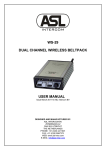Download User Manual PS 430 [ASL]
Transcript
PS 430 FOUR CHANNEL SPEAKER STATION USER MANUAL Issue 2011 © ASL Intercom BV DESIGNED AND MANUFACTURED BY: ASL INTERCOM BV ZONNEBAAN 42 3542 EG UTRECHT THE NETHERLANDS PHONE: +31 (0)30 2411901 FAX: +31 (0)30 2667373 E-MAIL: [email protected] WEB: www.asl-inter.com CONTENT OF THIS USER MANUAL 1.0 2.0 3.0 4.0 5.0 6.0 7.0 8.0 9.0 10.0 11.0 12.0 13.0 GENERAL DESCRIPTION ............................................................. 3 UNPACKING .................................................................................. 3 INSTALLATION .............................................................................. 3 WARRANTY ................................................................................... 3 FRONT PANEL CONTROLS & CONNECTOR ............................... 4 SIDE PANEL CONNECTORS ........................................................ 5 INTERNAL CONTROLS ................................................................. 6 TECHNICAL SPECIFICATIONS PS 430 ........................................ 6 PARTY LINE, TECHNICAL CONCEPT .......................................... 6 CABLING........................................................................................ 7 BLOCK DIAGRAM PS 430 ............................................................. 8 EARTHING CONCEPT................................................................... 8 SYSTEM CONFIGURATION .......................................................... 9 PAGE 2 User Manual PS 430 / Issue 2011 © ASL Intercom BV . 1.0 GENERAL DESCRIPTION The PS 430 is a four channel speaker station designed for use in both portable and fixed intercom systems. It incorporates a loudspeaker, a gooseneck microphone and a headset connector. The unit provides full duplex communications within an ASL intercom system. The PS 430 RM model has a small built-in electret microphone. Each channel has a Volume (listen level) control, a Talk and Call button with LED indicators and a twostage side tone trimmer. A master volume controls the total speaker/headset volume. The unit is equipped with a limiter for the gooseneck microphone, allowing the user to speak close into the microphone without giving rise to overload and distortion. Loudspeaker dimming is automatic when the microphone is active. Private conversation may be carried out with a headset or telephone handset connected to the unit. When a headset is connected, both gooseneck microphone and speaker are disabled automatically. 2.0 ASL has taken great care to ensure this product reaches you in flawless condition. Fully electronic switching increases reliability and allows for : o 'soft' microphone ON switching, latched or momentary o remote Mic Mute facility. o automatic speaker attenuation when the gooseneck microphone is activated. After unpacking the unit please inspect for any physical damage to the unit, and retain the shipping carton and relevant packing materials for use should the unit need returning. If any damage has occurred, please notify your dealer immediately so that a written claim can be initiated. Please also refer to the guarantee section of this manual. INSTALLATION This PS 430 may form part of an existing or new intercom system,. To connect the PS 430 to the system, use professional flexible microphone cable with 2 wires and 1 shield only. These cables may be connected to the LINE connector sockets on the PS 430 side panel, using the Y-cords. 4.0 The unique ASL CALL system provides both a flashing red LED and a very distinctive and characteristic sound signal. Smooth operation is guaranteed with the CALL button. Only a slight touch makes the red LED flash, whilst holding the button for two seconds will activate the CALL sound signal. The volume of the sound signal (buzzer) can be adjusted at the front panel. UNPACKING The shipping carton contains the parts listed below: o The PS 430 o Two Y-cords (XLR-5 > 2x XLR-3) o This user manual If any are missing, contact your dealer. 3.0 Special attention has been paid to the intelligibility of speech. By applying low noise/high speed op-amps, a speech presence filter and a specially developed high power bridged headphone amplifier, communication is very comfortable even in environments with high background noise level. There is a separate amplifier for the loudspeaker. The PS 430 is fully protected against wiring mistakes (reverse power) or short circuit in the interconnect cables. A special kit is available for mounting the PS 430 in a 19" rack, taking 2U of rack space WARRANTY This unit is warranted by ASL Intercom to the original end-user purchaser against defects in workmanship and materials in its manufacture for a period of one year from date of shipment to the enduser. Faults arising from misuse, unauthorized modifications or accidents are not covered by this warranty. If the unit is faulty it should be sent in it's original packing, to the supplier or your local ASL dealer, with shipping prepaid. A note must be included stating the faults found and a copy of the original suppliers invoice. PAGE 3 User Manual PS 430 / Issue 2011 © ASL Intercom BV . 5.0 FRONT PANEL CONTROLS & CONNECTOR 1 LISTEN LEVEL control knobs These knobs preset the listen level for each channel separately. 2 TALK buttons These push buttons allow talking to each channel separately or to some channels simultaneously. When a TALK button is switched on, its large green LED is lit. Momentary switching: When a TALK button is pushed and held, the microphone signal is sent to the referring intercom channel until the button is released. Latched switching: When a TALK button is pushed shortly, it is electronically latched and the microphone signal is sent to the referring intercom channel. When pushed again, the TALK button switches off. Mic Mute when latched on: After on an intercom channel a so-called Mic Mute signal has been received from a PRO Series master station or power supply, the connection between microphone and that intercom channel is interrupted. By pushing the TALK button, that connection is restored again. 3 CALL buttons These push buttons activate the call system, for each channel separately. By a momentary push a call signal is sent to all stations connected to the referring intercom channel and all Call LED’s start flashing. Pushing and holding the CALL button for 2 seconds activates the call buzzer, provided there is no buzzer mute signal on the referring channel. After the CALL button is released the LED’s continue to flash for a further 2 seconds. 4 MASTER VOLUME knob This knob functions as the master volume control of the listen levels of the 4 intercom channels (see also #1), for both the speaker and the headset. 5 SIDE TONE LEVEL trimmers These trimmers (one for each channel) are for minimizing the speaker feeding back into the gooseneck microphone (unit feedback); They also determine the level of your own voice as you hear it in the speaker or headset. 6 SIDE TONE HI trimmers These trimmers have the same functions as trimmers #5, but solely for the high frequencies. Adjustment procedure, for each channel separately: o set trimmers in start position: fully clockwise o switch off the microphones of all connected (speaker-) stations o make sure that there is no automatic speaker attenuation (turn trimmer #7 fully clockwise) o push the TALK button of the channel of which one wants to adjust the side tone. o Slowly turn up the listen volume of the PS 430 (channel- and master volume). o speak into the gooseneck microphone o adjust the speaker listen level to a minimum by turning the side tone trimmers counterclockwise (first trimmer #5 and then trimmer #6; repeat this a few times) o connect a headset to the PS 430 (the speaker and gooseneck are now automatically disabled) and speak into the headset microphone o check whether the level of your voice in the headset can(s) is sufficient. If not, push up this level a bit by turning side tone trimmer #5 clockwise. PAGE 4 User Manual PS 430 / Issue 2011 © ASL Intercom BV . The trimmer operating area is between fully clockwise and minimum level. Adjusting the side tones does not affect the level of your voice as it is heard by other stations. 7 SPEAKER ATTENUATOR trimmer This trimmer adjusts the extent to which the loudspeaker is automatically dimmed when the gooseneck microphone is switched on. It prevents unit feedback if side tone rejection is not sufficient. It also minimizes system feedback or a 'hollow' sound when the gooseneck microphones of other speaker stations (on one or several of the connected party lines) are switched on as well. Adjustment procedure : o make sure that there is no headset connected o switch off all TALK buttons of the PS 430. o inject an audio signal on one of the intercom channels via the aux input of a Pro Series master station or separate power supply o turn up the listen volume of the PS 430 (channel – and master volume). o activate the gooseneck microphone (push the TALK button of the selected channel) o adjust the desired degree of speaker attenuation (turning the trimmer counterclockwise increases the attenuation) 8 BUZZER VOLUME trimmer This trimmer adjusts the volume of the buzzer, which is located behind the front panel. The buzzer is activated when the CALL button of the PS 430 (or a CALL button of any other station on the party lines to which the PS 430 is connected) is pushed for longer than 2 seconds, provided there is no Buzzer Mute Signal on these party lines coming from a Pro Series master station or separate power supply. 9 HEADSET connector This is an XLR-4 connector for the connection of a local headset when private conversation is desired. The headset must have a can impedance of minimum 200 ohms. When the headset has two cans in parallel, each can must have an impedance of minimum 400 ohms. The headset microphone may be of the dynamic or electret type Pin assignments headset connector : Pin 1. Shield Mic. (GND) Pin 2. mic. + Pin 3. phones + Pin 4.. phones When connecting a headset, loudspeaker and gooseneck microphone are disabled automatically. 10 GOOSENECK microphone This a noise canceling microphone. A limiter prevents the mic pre-amp from clipping when speaking close in the microphone. The gooseneck mic. is automatically disabled when a headset is connected to the PS 430. 11 LOUDSPEAKER This is a high quality loudspeaker driven by a 2.9 Watt amplifier. The speaker is automatically disabled when a headset is connected to the PS 430. 6.0 SIDE PANEL CONNECTORS For linking the XLR-5 sockets to XLR-3 intercom line connectors, each PS 430 comes with two Y-cords, having an XLR-5 connector at one end and two XLR-3 connectors at the other end. On the Y-cords, the XLR-3 with the white ring corresponds with channel A or C. 12 LINE connector for channel A & B 13 LINE connector for channel C & D These two XLR-5 connectors are for connecting the PS 430 to the party lines of the intercom system. One connector is for channels A and B, one connector for channel C and D. Pin assignment XLR-5 connector 1. 0 V / ground shield 2. +30 V power wire channel 3. audio wire channel 4. +30 V audio wire channel 5. audio wire channel #12 A+B A A B B Pin assignment XLR-5 connector #13 1. 0 V / ground shield 2. +30 V power wire channel 3. audio wire channel 4. +30 V audio wire channel 5. audio wire channel C+D C C D D PAGE 5 User Manual PS 430 / Issue 2011 © ASL Intercom BV . 7.0 INTERNAL CONTROLS MIC GAIN trimmers Inside the unit there are two trimmers to adjust the mic gain of the gooseneck microphone and the headset microphone separately. These internal controls are located on a PC board. 8.0 They can be reached as follows : o remove the screws of the bottom plate o slide the plate to one side and take it out o take away the plastic isolation plate The trimmers are labeled ‘GOOSE’ for the gooseneck microphone and ‘HEADS’ for the headset microphone TECHNICAL SPECIFICATIONS PS 430 System dynamic range: 80 dB call send signal: +2.8 mA call signal threshold (receive): +2.4 V DC supply voltage: +30 V DC (12 - 32 V DC) power interrupt time (mic mute): 0.1 sec Intercom Line Impedance: 350 Ω (1kHz), 2.2 kΩ (DC) audio level: nom. -18 dBu, max. +4 dBu Mic. Pre-amps gooseneck mic: noise cancelling electret headset mic. impedance: 200 Ω gain: 40 - 60 dB (adjustable internally) presence filter: +6 dB at 5 kHz frequency response: 200 Hz - 13 kHz (-3 dB) power to electret mic: +9 V DC Speaker Driver Amp speaker impedance: 25 Ω max. output power: 2.9 W rms Headphones Driver Amps max. output level: monaural: 14 V rms @ 200 Ω binaural: 2x 10.6 V rms @ 400 Ω max. output power: monaural: 1 W rms @ 200 Ω binaural: 2x 0.28 W rms @ 400 Ω Power Consumption PS 430 current (at 30 V DC): 70 mA quiescent 105 mA signaling 230 mA at max. output + signaling Dimensions & Weight PS 430 width: 283mm height: 88 mm depth: 42/48 mm sloping weight: 1550 grams Side Tone Rejection: 0 - 30dB adjustable Buzzer max. SPL: 85 dBA 0 dBu defined as 775 mV into open circuit ASL reserves the right to alter specifications without prior notice 9.0 PARTY LINE, TECHNICAL CONCEPT User stations in an ASL intercom system are connected via one or several 'party lines'. A party line offers two way (‘full duplex’) communication and consists of standard microphone (multi-pair) cable. One wire is used as an audio line, one as a power line and the screen of the cable functions as earth/return. Current drive is used for signal transfer. Each station utilizes a current amplifier to amplify the microphone signal and place it on the common audio line where, due to the constant line impedance (situated in the power supply between XLR pin 3 and 1), a signal voltage is developed which can be further amplified and sent to the headphones or loudspeakers. This principle has three advantages: the use of a single audio line allows several stations to talk and listen simultaneously due to the high bridging impedance offered by each station, the number of stations on the party line has no influence on the level of the communications signal power and audio to the intercom stations use the same cable The Call signal is also sent as a current on the audio line. It develops a DC potential over the line impedance which will be sensed by each station and interpreted as a Call signal. PAGE 6 User Manual PS 430 / Issue 2011 © ASL Intercom BV . 10.0 CABLING . The intercom lines (the ‘party lines’) are of the shielded two-conductor microphone cable type. The intercom line connectors are of the XLR-3 type. Audio and Call signals are on pin 3, DC power is on pin 2 and pin 1 is connected to the shield of the cable which functions as the common return for audio and power. The audio signal is transferred in an unbalanced way (see ‘Party Line, Technical Concept’). To avoid earth loops (hum), the possible effect of electromagnetic fields and to minimize power loss, certain rules have to be obeyed when installing the cabling of an intercom system : Use high quality cable Use high quality microphone cable (shielded two conductor cable, minimum 2x 0.30 mm2). In case multi-pair microphone cable is used, there should be an overall shield and each pair should consist of two conductors (minimum 2x 0.15 mm2) with separate shield. Keep cables parallel as much as possible When two (multi channel) units in a network are connected by more than one cable, make sure that these cables are parallel to each other over the whole distance between those units. When using multi-pair cable, parallelism is ensured in the best possible way. Use flexible cable Use flexible single and multi-pair microphone cable instead of cable with solid cores, especially when the cable is subjected to bending during operation or installation. Avoid closed loops Always avoid that intercom cables are making a closed loop. So-called 'ring intercom' should not physically be cabled as a ring.. Cable screens to XLR pin 1 The screen of each separate microphone cable and/or the screen of each single pair in a multi-pair cable, should be connected to pin 1 of each XLR-3 connector. Do not connect these screens to the metal housing of ASL unitst or XLR-3 wall boxes. See section ‘Earthing Concept’. Connect metal cable trunks, wall boxes and overall multi-pair cable screens to clean earth Metal cable trunks, metal wall boxes and overall multi-pair cable screens should be interconnected and, at the 'central earth point' in the intercom network only, be connected to a clean earth or a safety earth. (see section ‘Earthing Concept’). Keep metal connection boxes and cable trunks or pipes isolated from other metal parts Metal trunks or pipes for intercom cables and metal connection boxes should be mounted in such a way that they are isolated from any other metal housing or construction part. Keep cables away from electromagnetic sources Keep intercom cables away from high energy cables, e.g. 115/230/400V mains power or dimmer controlled feeds for spotlights. Intercom cables should cross high energy cables at an angle of 90º only. Intercom cables should never be in the same trunks as energy cables. Place power supply in a central position In case of a system powered by a separate power supply: In order to diminish power losses, place the power supply as close as possible to where most power consumption occurs, in other words most user stations are placed. ASL powered units to a 'clean' mains outlet Master stations or power supplies should be connected to a mains outlet with a clean earth. Other audio equipment may be connected to this mains outlet, but avoid using an outlet which also powers dimmer controlled lighting systems. In case of more complex installations, don’t hesitate to contact us. Please send us a block diagram of the planned intercom network with a list of all user stations and their positions, and we are happy to advise you on cabling lay out. PAGE 7 User Manual PS 430 / Issue 2011 © ASL Intercom BV . 11.0 BLOCK DIAGRAM PS 430 12.0 EARTHING CONCEPT PAGE 8 User Manual PS 430 / Issue 2011 © ASL Intercom BV . 13.0 SYSTEM CONFIGURATION 13.0 SYSTEM CONFIGURATION PAGE 9 User Manual PS 430 / Issue 2011 © ASL Intercom BV .









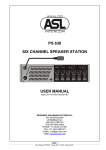
![User Manual PS 260 [ASL]](http://vs1.manualzilla.com/store/data/006916739_1-983cb380987130e2fe2cf762515f3398-150x150.png)

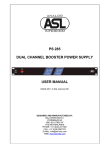
![User Manual PS 260 [ASL]](http://vs1.manualzilla.com/store/data/005875222_1-79f7ffd37f8e6cc3732f57605cc0b82b-150x150.png)
![User Manual PS 260 [ASL]](http://vs1.manualzilla.com/store/data/005887031_1-132c7eb8ac96774a27528798f7f3ad09-150x150.png)
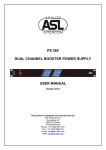

![User Manual PS 260 [ASL]](http://vs1.manualzilla.com/store/data/005945478_1-a7dc8230481a9f04873ba664e1b890b7-150x150.png)
![User Manual BS 15 [ASL]](http://vs1.manualzilla.com/store/data/005996459_1-9378f5a1cc1ed113f3d71e1dad6bbd12-150x150.png)
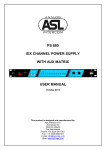

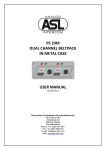
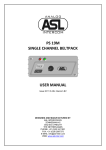



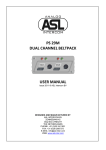
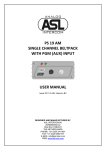
![User Manual PS 150 [ASL]](http://vs1.manualzilla.com/store/data/005768686_1-8816d5b7fb10913376d12c46f49c4ab8-150x150.png)
![User Manual PS 150 [ASL]](http://vs1.manualzilla.com/store/data/005931236_1-174adb133314d678a055d12476aff946-150x150.png)
